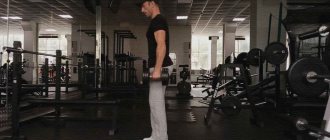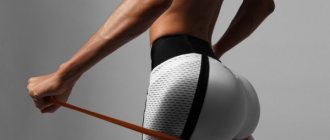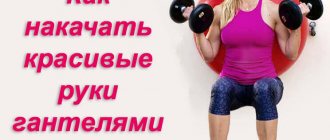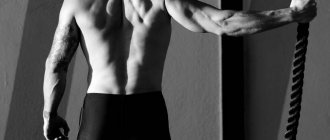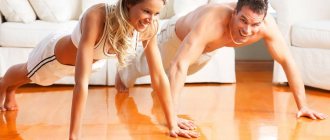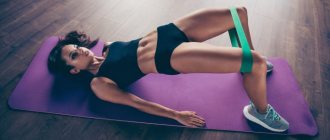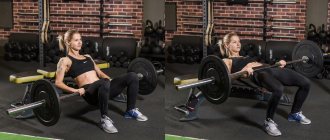Genetics largely determines our appearance, but do all those with beautiful buttocks have Brazilian roots? Of course not.
A clear understanding of your body type will help you build a training plan and diet, regardless of your individual characteristics.
Egor Fukalov
fitness trainer
Offers to try training for firm buttocks at home.
Photo: istockphoto.com
Don’t rush to blame everything on nature and give up training. Some are less fortunate with genetics, but they have incredible shapes. On the other hand, many girls with genetically beautiful buttocks do not have toned relief.
Round buttocks - genetics or work?
We would like to please you that muscles can be increased in size and made to the volume that you will be satisfied with. The gluteus maximus muscle is one of the strongest and largest muscles in humans, so it quickly and noticeably increases in volume.
How to make your daily squats as effective as possible?
Warm-up
Our biggest enemy is laziness. With the development of technological progress, the life of modern man can no longer be compared with the life of distant ancestors. Now there is no need to hunt mammoths: everything you need is in stores, and it’s even easier to prepare your own food, because the kitchens of modern housewives are equipped with everything necessary to facilitate this process. A person can provide himself with everything he needs, without even leaving home, via the Internet, but in addition to the advantages, such an existence also has disadvantages. The number of people suffering from excess weight on our planet is steadily growing.
Therefore, you should not wait for the situation to go too far. It is necessary to take measures to restore your motor activity. After all, movement is life, remember this. If your thighs have lost their former shape, and obvious signs of cellulite are visible on your skin, it’s time to take a closer look at yourself. How to tighten your hips at home and is it possible? Anything is possible if you have the incentive and desire to live as long as possible, remaining vigorous and full of strength. The main thing is to do everything according to the rules and not immediately throw yourself into the embrasure, trying to make up for lost time in one day. This will only result in aching muscle pain due to heavy exercise, and the next day you won’t even be able to get out of bed.
First you need to get mentally ready and warm up. It is designed to increase cardiovascular activity, get aerobic exercise and stretch the muscles - prepare them for training. Warming up will significantly improve your productivity, which means you can do more without much stress than without it. It also speeds up metabolism and makes training as effective as possible. Well, one more important plus: warming up exercises reduce the risk of injuries and sprains. How to pump up your thigh muscles will be discussed below, but for now here are some warm-up exercises:
- walking in place . In this case, the knees need to be raised so high that the thighs are parallel to the floor;
- running in place or on a treadmill;
- heel pressure on the floor . Bend your supporting leg, extend the other leg forward and place it on your heel. Stretch your arms in front of you. Apply pressure for one minute;
- shoulder rotation, tilting and head rotation;
- body tilts in different directions, mill;
- swinging legs, rising on tiptoes.
How to make your gluteal muscles grow?
- Eat enough protein, fat and carbohydrates.
- Do workouts to increase muscle mass.
- Recover fully after your workout.
- Use additional weights.
- Constantly but gradually increase the load.
To track your results, take measurements with a tape measure every month. This will allow you to see progress from your efforts.
Photo: istockphoto.com
A set of exercises for the thigh muscles with weights
Our selected set of strength exercises
includes the following basic and isolating exercises of varying difficulty:
● Barbell squats; ● Squats with dumbbells; ● Hack squats; ● Leg straightening while sitting; ● Deadlift.
The following technique for performing exercises with weights will allow you to involve both the quadriceps and other thigh muscles in active work. The muscular system of the body as a whole will receive an accompanying load. Basic exercises with a barbell and, in general, using heavy weights are best suited for progressive mass growth and increasing strength.
During the week, it will be quite enough to conduct one intense workout for the quadriceps with heavy weights. On other days, you can focus on exercises for other muscle groups in the thigh and with a higher number of possible repetitions. Focusing on a specific muscle group in one workout, for example, doing exercises for the biceps of the legs or quadriceps, will allow you to better load the muscles in individual groups. The optimal option is 2-3 workouts per week, including in a combined mode 1 strength complex exercise with heavy weight, 1 simpler basic exercise and 1 isolating exercise. However, ultimately determine the individual set of weight training exercises according to your training goals and capabilities.
It is important to remember the need for recovery both directly during training (resting between approaches from 1 to 3 minutes) and between them. Don’t forget also about warm-up exercises to stretch the thigh muscles, for which static and aerobic exercise options are good. And just as important as everything else, be sure to adjust your food intake according to your training regimen with sufficient protein intake. With the right approach, you will soon be able to boast of significant results from performing exercises with weights, and your pumped up and sculpted thighs will remain with you in excellent shape for a long time.
A simple set of exercises for your dream buttocks at home
You don't have to go to the gym to pump up your buttocks. If you really want to, you can practice at home. Such training is no worse and will give a similar result if you approach it responsibly.
Single leg glute bridge
Technique:
- Lie on your back, one leg bent at the knee with emphasis on the heel, the second is located on the thigh of the first and bent 90°.
- Push your pelvis upward powerfully until it is in a straight line with your back, pausing at the top point for one second.
- Lower yourself smoothly to the floor for 2-3 seconds.
Perform three sets of 20 reps. Rest between sets is one minute.
Wide Leg Squats
Technique:
- Legs wider than shoulders.
- Turn your feet to the sides 45°.
- Bend slightly at the waist. The back is tilted forward towards the floor. Look ahead.
- Take a deep breath and smoothly lower your pelvis down and back until your thighs are parallel to the floor.
- Exhale and push yourself up with a powerful movement, smoothly straightening your back.
Perform three sets of 20 reps. Rest between sets is one minute.
Bulgarian lunges with horizontal back
Technique:
- The back is straight with a slight arch in the lower back, inclined towards the floor. Shoulders together, chest forward.
- Front and back legs at a 90° angle at the knees.
- The distance between the knee of the hind leg and the floor is 5-10 cm.
- The back leg is used only to maintain balance.
- Take a deep breath and slowly lower yourself down until your front thigh is parallel to the floor.
- Exhale and push yourself upward with a powerful movement.
Perform three sets of 20 reps. Rest between sets is one minute.
Romanian deadlift
Technique:
- Legs are narrower than shoulder width. The back is straight, arms are lowered down and holding weights (this could be dumbbells, a barbell or a bottle of water).
- Take a deep breath and smoothly move your pelvis back, as if you want to sit on a chair, and tilt your body forward. Stay in this position for one second.
- As you move down, maintain a slight arch in your lower back. When abducting your pelvis, bend your knees slightly.
- Exhale and smoothly straighten your back with a powerful movement.
Perform three sets of 20 reps. Rest between sets is one minute.
Leg abduction on all fours
Technique:
- Get on all fours and bend at the waist.
- Take your bent leg back and up and fix it at a distance of 5 cm from the floor.
- Exhale and smoothly lift your leg up using your hip. Stay in this position for one second.
- Inhale smoothly and lower your hip toward the floor for two seconds.
- Monitor your lower back position throughout the exercise. It should not be included in the work.
Perform three sets of 20 reps. Rest between sets is one minute.
You can think a lot and for a long time about bad genetics, or right now you can take it and start working on yourself, define a goal and believe in yourself. In this case, the result will be 100%.
How to get your buttocks in shape?
In order for your butt to look the way we often see on female models in photos or advertisements, you will have to work hard on yourself. But the result is worth it, isn't it?
Squat.
No matter how banal this exercise may seem, it occupies one of the leading places in the fight for beautiful hips. Fitness instructors and gym trainers advise doing it this way: stand with your feet shoulder-width apart and squat a little more than 90 degrees, but do it so that your heels remain on the floor. Moreover, it is important that at this moment the position is comfortable, that is, stable in any position. Sometimes it is enough to slightly change the width at which the legs are placed, and the optimal solution will be immediately found. So it is not at all necessary to squat all the way to the floor. You can start with 15 repetitions, and then increase the number of repetitions.
Swing your legs.
Regular leg swings are also considered no less effective. In order to perform them, it is enough to stand at a table or wall, lean one hand on a support and begin to swing one leg to the side forward and backward. It is best to start by performing this exercise 10 times in three approaches, changing legs. Movements should not be sudden. The same can be done if you raise your legs alternately up and down, turning sideways to the table.
A little anatomy
The hamstrings are a group of three major muscles on the back of the thigh. Let's look at these muscles and their functions.
The biceps femoris (located along the outside of the thigh), semitendinosus (located in the middle) and semimembranosus (located towards the inner thigh) originate under the gluteus maximus on the pelvic bone and attach to the tibia of the leg. The hamstrings are responsible for knee flexion (pulling the heel toward the buttocks), hip extension (pulling the leg back), and slowing the movement of the lower leg.
In terms of function, it is very easy to understand the importance of developing the biceps femoris muscles, since the work of other muscles depends on them. For example, the hamstrings play an important role when performing squats, hack squats, front squats, leg presses, or lunges. Even muscle development (balance) is not only a visual aspect that will be assessed on stage, it is of great importance when training the entire lower body. Without properly trained hamstrings, you will not be able to properly tone your quadriceps.
Building strong thighs
Now that you know about anatomy and movement mechanisms, let's figure out how to get impressively developed thighs. The movements and exercises presented are designed to get maximum results every time you visit the gym. Remember to always use proper technique and not lift too much weight to risk your safety.
Leg bends in a lying and sitting position
The lying leg curl machine is a standard but very effective way to isolate the hamstrings, especially the lower portions. Simply adjust the roller so that it rests on the back of the Achilles tendon. The knees must be aligned with the axis of the machine to perform the exercise correctly.
Leg bending in a lying machine
Place your feet approximately shoulder-width apart on the bolster. Then bend your legs until the roller (almost) touches the back of your thighs or buttocks. Controlling the movement, return to the starting position by straightening your legs, but do not suddenly release the weight.
When performing seated leg curls, your body should be positioned approximately the same. Adjust the bolster as above and position the seat so that your knees are aligned with the axis of the machine. Fix the upper roller well at your hips so that you sit motionless in the machine.
Seated leg curls
Perform the exercise by bending your legs until you feel a strong muscle contraction. Control all movements! Avoid partial movements and make sure you use moderate weights to ensure full range of motion is achieved.
Advice:
Try changing the position of your feet/legs on the roller to target different parts of your hamstrings. For example: perform a set with a wide stance, the next with your feet shoulder-width apart, and the last with your feet together. This way you can ensure that every part of the biceps is working and the muscles are developing evenly.
Leg curls (one at a time) while standing
Similar to the sitting and lying leg curls, the standing leg curl machine allows you to isolate one leg. These "one-sided" workouts cause the muscles to contract more with each repetition.
Standing leg curls
Simply stand in the machine (most will require you to have one foot on your knee on a pad and the other on an ankle pad), bend your working leg through a full range of motion, and squeeze your hamstrings hard.
You can easily rotate your lower body to do a couple more reps, but try not to do this. Not only will you not develop the muscles properly, but you may also risk injury in the lower back/torso area.
Return the load to its original position, without releasing it completely, however. Make sure you maintain a constant load on the muscles you are working.
Advice:
When performing a unilateral exercise such as a standing single leg curl, try to alternate legs without rest periods. When one leg works, the other one rests, so there is no need for breaks after each approach. A few seconds are fine, but try to avoid full periods of rest. Your biceps muscles will thank you later!
Romanian deadlift and stiff legged deadlift
In the world of weight training, questions often arise about the differences between the Romanian deadlift and the stiff-legged deadlift. First of all, the Romanian deadlift is performed with slightly bent knees and the load pointing straight down. This exercise mainly targets the development of the hamstrings and gluteal muscles.
Romanian deadlift
The second type of deadlift is performed with almost straight legs (some straighten them completely) and with a slightly rounded lower back. This exercise works the hamstrings and lower back muscles. Both exercises help develop the biceps femoris muscles. Unlike leg curl machines, Romanian deadlifts and stiff legged deadlifts work the glutes and upper hamstrings more.
Deadlift with a barbell with straight legs
To perform the Romanian deadlift, place a barbell in front of you and place your feet shoulder-width apart. Grasp the barbell at a shoulder-width distance and lift it up to the starting position (the barbell should be pressed against your hips).
Bend your knees slightly and fix your body in this position (your legs should remain half-bent throughout the entire exercise). Bend at the hips rather than at the back, lower the bar to about mid-calf and feel the stretch in your thigh muscles.
Without jerking, reverse direction and lift the barbell up to the level of your upper thighs without fully straightening, this will keep the load on your biceps muscles. Remember that you need to bend at the hip joints, your back should remain as straight as possible (it will seem to you that you are pushing your pelvis far back). To begin with, use a small weight to master the technique of the exercise, then you can increase the load.
To perform the straight-legged deadlift, position your legs and arms as for the Romanian deadlift. This time, straighten your knees completely (or almost completely) and lower the barbell down, rounding your back slightly. Don't round your back too much with heavy weights! This will result in injury.
As you move down, keep the bar near your feet. You'll find that you can take it lower with this technique, so use light to moderate weights and do this exercise slowly and with control.
So what should you choose? Romanian deadlift or stiff legged deadlift? It is better for beginners to work with the first one, and experienced athletes can do the second one every third or fourth workout to diversify the program a little.
Advice:
Alternatively, you can use dumbbells instead of a barbell. When working with dumbbells, you can slightly change the technique of performing the exercise and they are convenient to use in a crowded gym when the barbell is occupied. Try both options and see which one suits you best.

